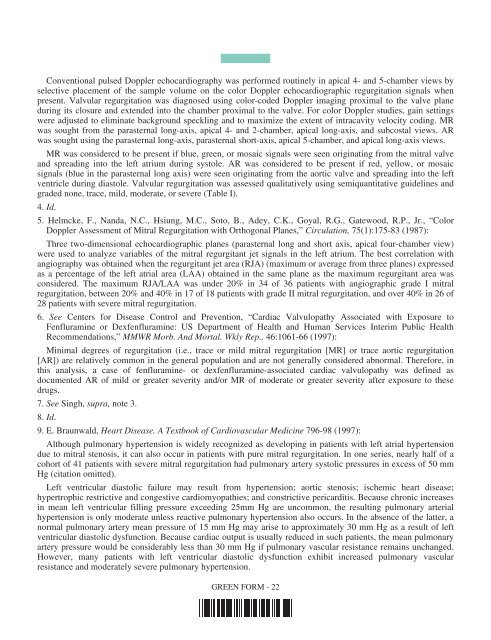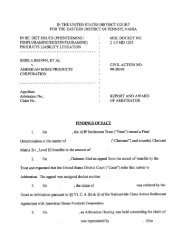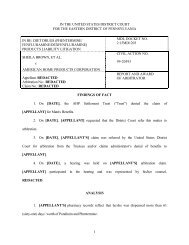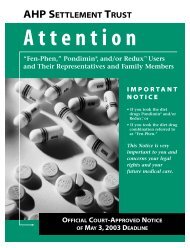GREEN Form - AHP Diet Drug Settlement
GREEN Form - AHP Diet Drug Settlement
GREEN Form - AHP Diet Drug Settlement
You also want an ePaper? Increase the reach of your titles
YUMPU automatically turns print PDFs into web optimized ePapers that Google loves.
Conventional pulsed Doppler echocardiography was performed routinely in apical 4- and 5-chamber views by<br />
selective placement of the sample volume on the color Doppler echocardiographic regurgitation signals when<br />
present. Valvular regurgitation was diagnosed using color-coded Doppler imaging proximal to the valve plane<br />
during its closure and extended into the chamber proximal to the valve. For color Doppler studies, gain settings<br />
were adjusted to eliminate background speckling and to maximize the extent of intracavity velocity coding. MR<br />
was sought from the parasternal long-axis, apical 4- and 2-chamber, apical long-axis, and subcostal views. AR<br />
was sought using the parasternal long-axis, parasternal short-axis, apical 5-chamber, and apical long-axis views.<br />
MR was considered to be present if blue, green, or mosaic signals were seen originating from the mitral valve<br />
and spreading into the left atrium during systole. AR was considered to be present if red, yellow, or mosaic<br />
signals (blue in the parasternal long axis) were seen originating from the aortic valve and spreading into the left<br />
ventricle during diastole. Valvular regurgitation was assessed qualitatively using semiquantitative guidelines and<br />
graded none, trace, mild, moderate, or severe (Table I).<br />
4. Id.<br />
5. Helmcke, F., Nanda, N.C., Hsiung, M.C., Soto, B., Adey, C.K., Goyal, R.G., Gatewood, R.P., Jr., “Color<br />
Doppler Assessment of Mitral Regurgitation with Orthogonal Planes,” Circulation, 75(1):175-83 (1987):<br />
Three two-dimensional echocardiographic planes (parasternal long and short axis, apical four-chamber view)<br />
were used to analyze variables of the mitral regurgitant jet signals in the left atrium. The best correlation with<br />
angiography was obtained when the regurgitant jet area (RJA) (maximum or average from three planes) expressed<br />
as a percentage of the left atrial area (LAA) obtained in the same plane as the maximum regurgitant area was<br />
considered. The maximum RJA/LAA was under 20% in 34 of 36 patients with angiographic grade I mitral<br />
regurgitation, between 20% and 40% in 17 of 18 patients with grade II mitral regurgitation, and over 40% in 26 of<br />
28 patients with severe mitral regurgitation.<br />
6. See Centers for Disease Control and Prevention, “Cardiac Valvulopathy Associated with Exposure to<br />
Fenfluramine or Dexfenfluramine: US Department of Health and Human Services Interim Public Health<br />
Recommendations,” MMWR Morb. And Mortal. Wkly Rep., 46:1061-66 (1997):<br />
Minimal degrees of regurgitation (i.e., trace or mild mitral regurgitation [MR] or trace aortic regurgitation<br />
[AR]) are relatively common in the general population and are not generally considered abnormal. Therefore, in<br />
this analysis, a case of fenfluramine- or dexfenfluramine-associated cardiac valvulopathy was defined as<br />
documented AR of mild or greater severity and/or MR of moderate or greater severity after exposure to these<br />
drugs.<br />
7. See Singh, supra, note 3.<br />
8. Id.<br />
9. E. Braunwald, Heart Disease. A Textbook of Cardiovascular Medicine 796-98 (1997):<br />
Although pulmonary hypertension is widely recognized as developing in patients with left atrial hypertension<br />
due to mitral stenosis, it can also occur in patients with pure mitral regurgitation. In one series, nearly half of a<br />
cohort of 41 patients with severe mitral regurgitation had pulmonary artery systolic pressures in excess of 50 mm<br />
Hg (citation omitted).<br />
Left ventricular diastolic failure may result from hypertension; aortic stenosis; ischemic heart disease;<br />
hypertrophic restrictive and congestive cardiomyopathies; and constrictive pericarditis. Because chronic increases<br />
in mean left ventricular filling pressure exceeding 25mm Hg are uncommon, the resulting pulmonary arterial<br />
hypertension is only moderate unless reactive pulmonary hypertension also occurs. In the absence of the latter, a<br />
normal pulmonary artery mean pressure of 15 mm Hg may arise to approximately 30 mm Hg as a result of left<br />
ventricular diastolic dysfunction. Because cardiac output is usually reduced in such patients, the mean pulmonary<br />
artery pressure would be considerably less than 30 mm Hg if pulmonary vascular resistance remains unchanged.<br />
However, many patients with left ventricular diastolic dysfunction exhibit increased pulmonary vascular<br />
resistance and moderately severe pulmonary hypertension.<br />
<strong>GREEN</strong> FORM - 22






